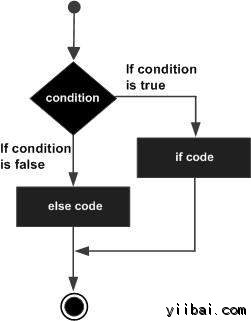R语言if...else语句
发布于 2016-01-02 09:36:14 | 7724 次阅读 | 评论: 0 | 来源: 网络整理
if语句可以跟着可选的 else语句,当 if语句布尔表达式是false时。else代码块将被执行。
语法
在R语言中的 if ... else 语句创建的基本语法是:
if(boolean_expression) {
// statement(s) will execute if the boolean expression is true.
} else {
// statement(s) will execute if the boolean expression is false.
}
如果布尔表达式为 true,那么 if 语句代码块将被执行,否则 else 代码块将被执行。
流程图

示例
x <- c("what","is","truth")
if("Truth" %in% x){
print("Truth is found")
} else {
print("Truth is not found")
}
当上述代码被编译和执行时,它产生了以下结果:
[1] "Truth is not found"
这里的 "Truth" 和 "truth" 是两个不同的字符串。
if...else if...else 语句
一个 if 语句可以跟着一个可选的 else if ... else 语句,使用单个 if...else if 语句来测试各种条件非常有用的。
当使用 if , else if , else 语句有几点要牢记。
-
if 语句后可以有零或一个 else 语句,它必须出现在 else if语句之后。
-
一个 if 语句 可有0到多个 else if 语句,它们一定在 else 语句之前。
-
一旦else if 匹配成功,剩余的 else if 是或 else 将不会被测试(执行)。
语法
创建 if...else if...else 语句的基本语法是:
if(boolean_expression 1) {
// Executes when the boolean expression 1 is true.
}else if( boolean_expression 2) {
// Executes when the boolean expression 2 is true.
}else if( boolean_expression 3) {
// Executes when the boolean expression 3 is true.
}else {
// executes when none of the above condition is true.
}
示例
x <- c("what","is","truth")
if("Truth" %in% x){
print("Truth is found the first time")
} else if ("truth" %in% x) {
print("truth is found the second time")
} else {
print("No truth found")
}
当上述代码被编译和执行时,它产生了以下结果:
[1] "truth is found the second time"